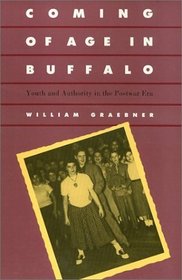Search -
Coming of Age in Buffalo: Youth and Authority in the Postwar Era
Coming of Age in Buffalo Youth and Authority in the Postwar Era
Author:
Pegged pants poodle skirts, record hops, rock ‘n’ roll, soda shops: in the interval between the bombing of Hiroshima and the assassination of John F. Kennedy, these were distinguishing marks of the "typical" postwar teenager-if there was a "typical" teenager. In this richly illustrated account of Youth in postwar Buffalo, William Graeb... more »
Author:
Pegged pants poodle skirts, record hops, rock ‘n’ roll, soda shops: in the interval between the bombing of Hiroshima and the assassination of John F. Kennedy, these were distinguishing marks of the "typical" postwar teenager-if there was a "typical" teenager. In this richly illustrated account of Youth in postwar Buffalo, William Graeb... more »
ISBN-13: 9781566391979
ISBN-10: 1566391970
Publication Date: 12/27/1993
Rating: ?
ISBN-10: 1566391970
Publication Date: 12/27/1993
Rating: ?
0 stars, based on 0 rating
Publisher: Temple University Press
Book Type: Paperback
Other Versions: Hardcover
Reviews: Amazon | Write a Review
Book Type: Paperback
Other Versions: Hardcover
Reviews: Amazon | Write a Review
Genres:
- Nonfiction >> Social Sciences >> Sociology >> General





